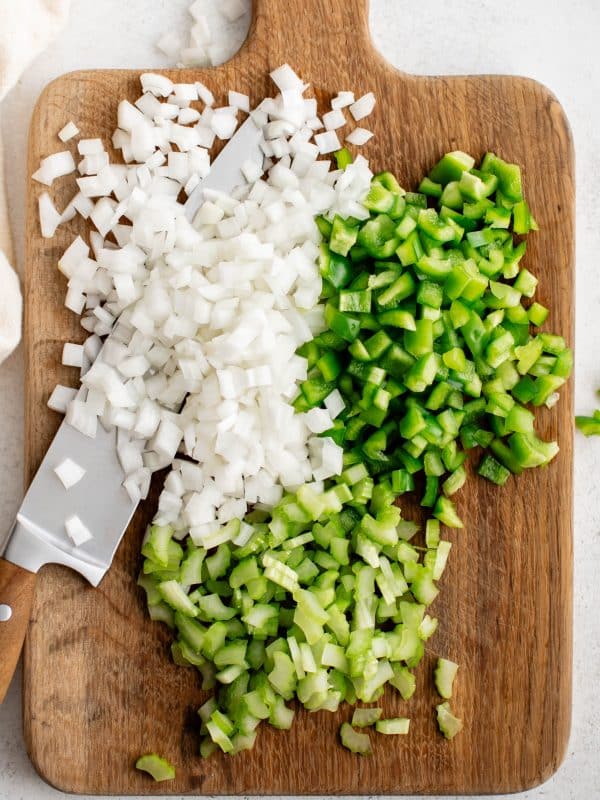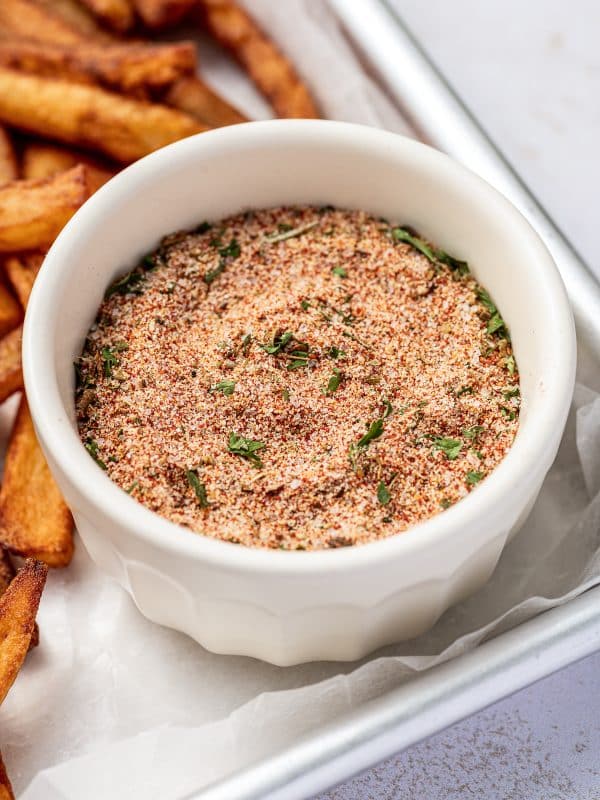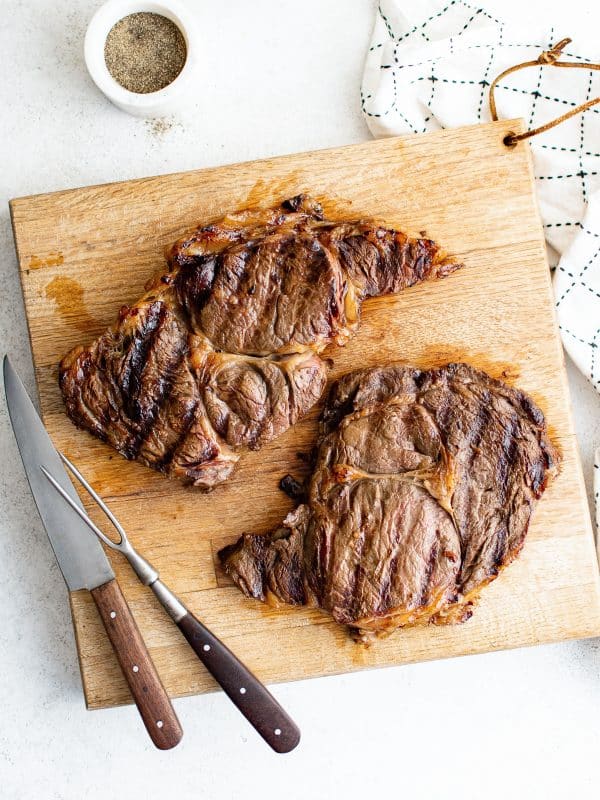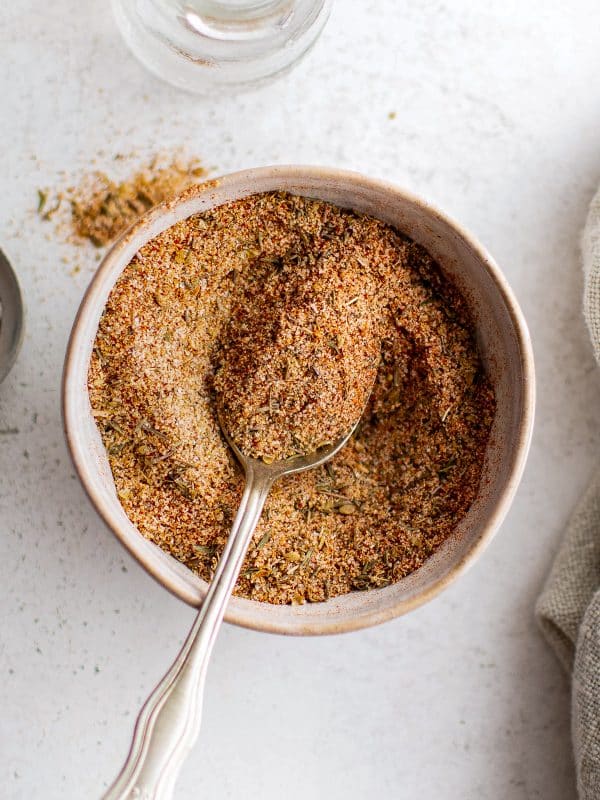This post may contain affiliate links. See my disclosure policy.
This Creole Seasoning Recipe is an essential spice blend for classic Creole and Cajun cuisine. Made with an incredible blend of bold and savory herbs and spices, it’s quick and easy to throw together, and the perfect seasoning for everyday dishes like grilled meats and roasted vegetables.

Today, I’m sharing how to make my go-to Creole seasoning mix. It’s a vibrant, complex, and deeply flavorful blend of dried peppers, herbs, and aromatics that infuses savory meats and stews with the robust (and honestly addictive) flavors of New Orleans, Louisiana. Cajun and Creole seasoning are very similar. If you love one, you’ll most likely love the other.
Table of Contents
Cajun Vs. Creole Seasoning
Cajun and Creole seasoning are basically the same thing; especially when comparing store-bought seasoning blends, which taste nearly identical (in my opinion). But, making them at home, gives you the chance to set the two apart. The belief is that Cajun seasoning is typically spicier, while Creole seasoning is more herb-forward.
But the truth is, Louisiana, and therefore its cuisine, has a seriously complex history and with that comes some very serious opinions (source). The most important takeaway is that Cajun and Creole cuisine are not the same thing. While there are some similarities, the two are not interchangeable. Creole is the more refined, aristocratic cousin to its swamp dwelling Cajun relatives.
Creole cuisine was developed by the diverse inhabitants of New Orleans and their access to New Orleans’ trade routes. It is known for its refined dishes, complex spices, and rich sauces. In contrast, the Cajuns who settled later in the remote regions of Louisiana s countryside, crafted their cuisine using ingredients they could hunt, fish, or forage in the bayous, relying on resourcefulness and bold, rustic flavors (source).
Put another way, Creole cuisine is often referred to as “city food”, while Cajun cuisine is known as “country food.”
What’s in Creole Seasoning?
This is how I like to make my homemade Creole seasoning mix. It’s a milder, more herb-forward version of my homemade Cajun seasoning. Here’s what you’ll need to make it:
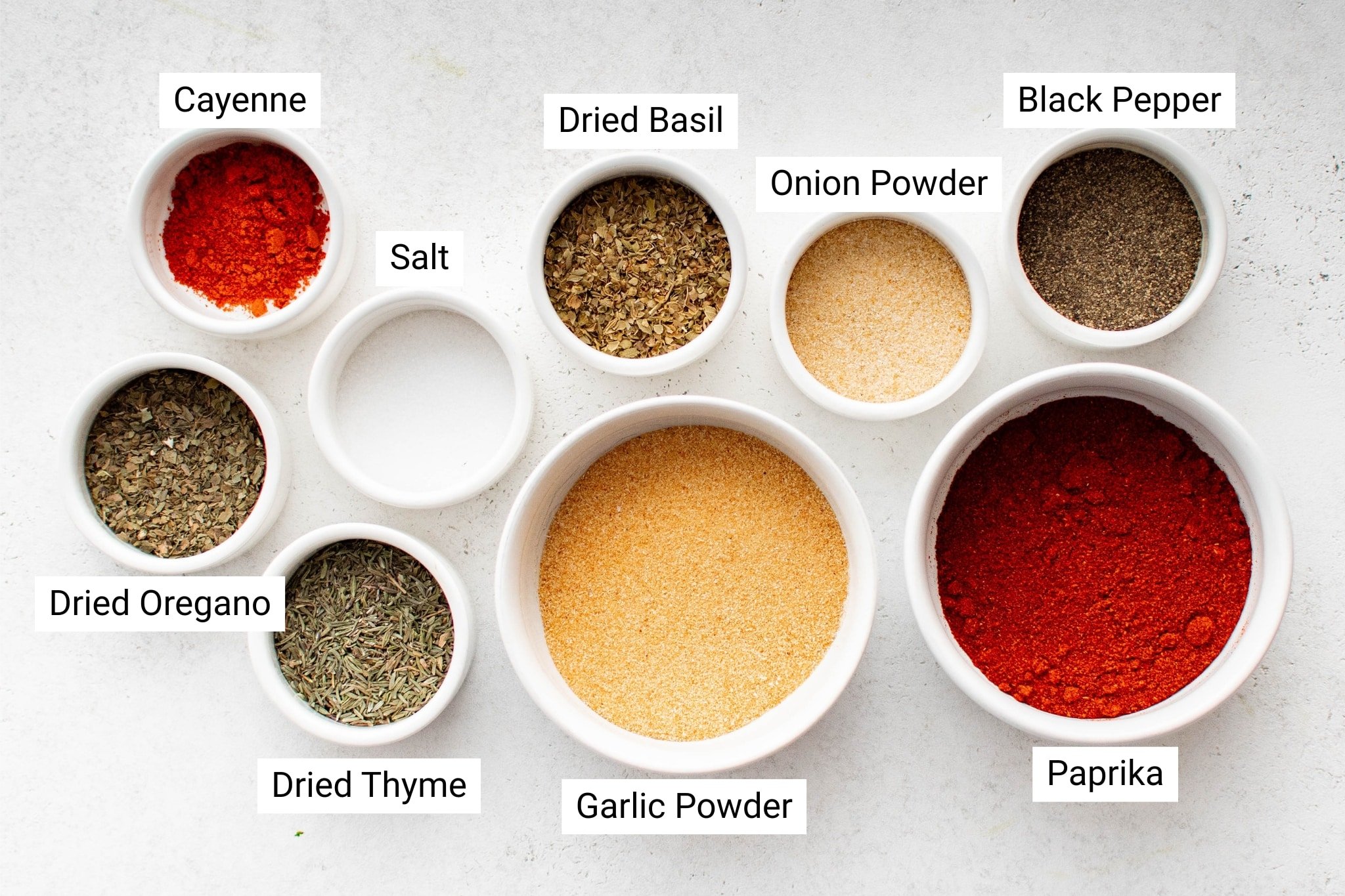
- Paprika: Fresh paprika is vibrant red and aromatic. Use sweet paprika for a mild, slightly smoky sweetness. For more complex flavor, try Spanish-style smoked paprika.
- Garlic Powder + Onion Powder: Purchase granulate or fine-grain powders with no added salt or anti-caking agents. Avoid using garlic or onion salt.
- Dried Herbs (Oregano, Thyme, Basil): For best results, purchase whole-leaf dried herbs and blend them in a spice grinder or small food processor when mixing. Pre-ground herbs also work, but they tend to lose their potency much faster.
- Cayenne Pepper: Purchase pure cayenne powder without fillers or chili blends. I do not recommend swapping with crushed red pepper as their flavors are quite different.
- Salt + Black Pepper: If you can, use freshly ground black pepper for the most bold flavor. Pre-ground pepper is great for convenience. For a low-sodium or salt-free version, simply omit the salt. And if you’re looking for an extra peppery kick (without heat) try adding a little white pepper.
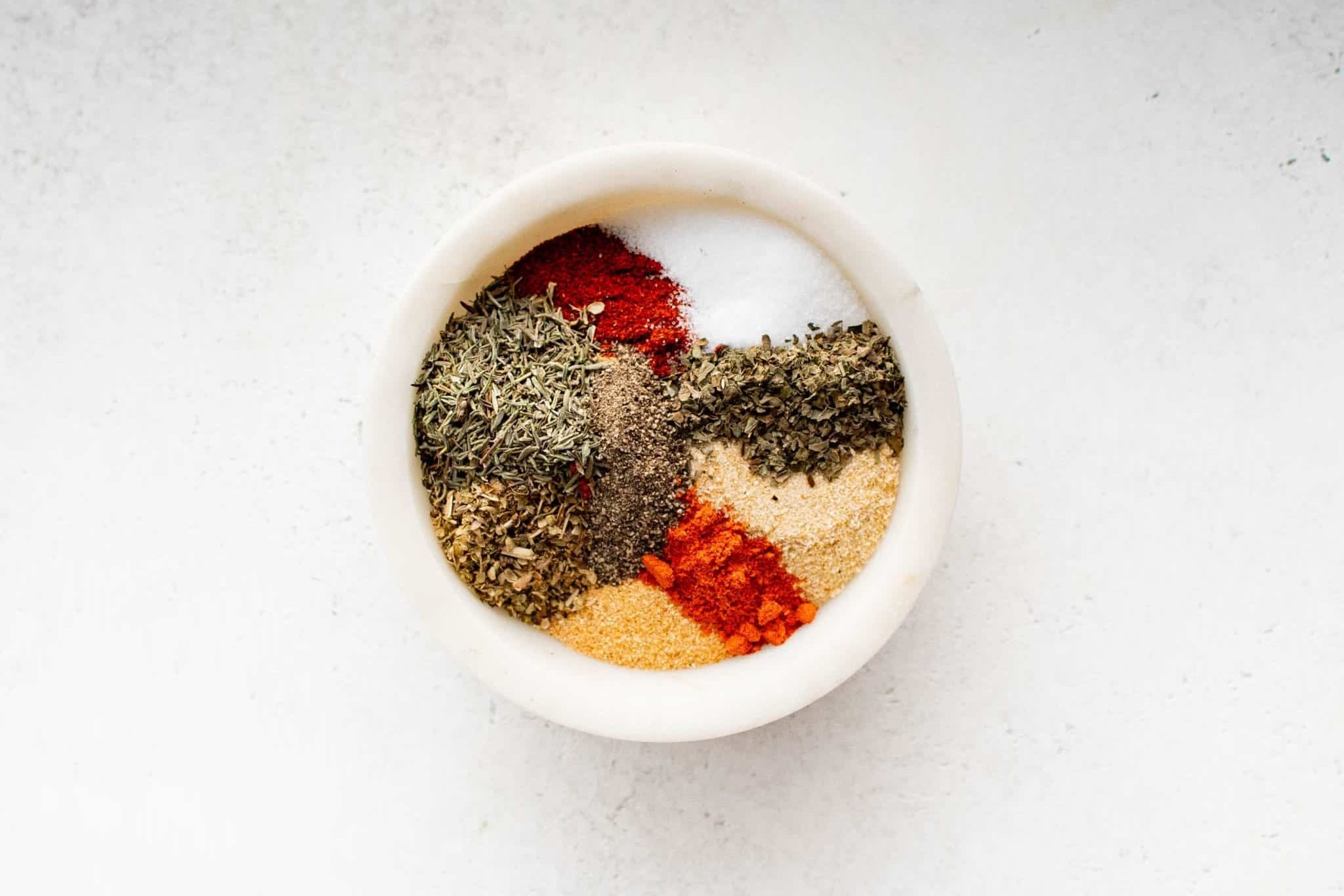
How to Make Creole Seasoning
The key to making a delicious homemade seasoning blend is to use the correct balance of herbs and spices. The flavors should complement, rather than overwhelm each other.
This is my version of a perfectly balanced Creole seasoning mix. Give it a try and make adjustments to suit your taste.
To make it, gather your dried herbs and spices. Check for freshness, especially if you plan to make a big batch. If you’re using whole-leaf dried herbs, grind them in a mortar and pestle or give them a quick pulse or two in a spice grinder. Then, add them to a medium bowl with the paprika, garlic powder, onion powder, cayenne pepper, salt, and black pepper, mixing well to combine.
Creole Seasoning Recipe
Storage Tips
Transfer your prepared seasoning mix to an airtight container, mason jar, or clean spice jar. Using a funnel helps transfer the spices without making a mess. Store in a cool, dry place for up to 6 months, although it’s recommended to use within 2-3 months for best flavor and freshness.

Frequently Asked Questions
The best substitute for Creole seasoning is Blackened seasoning or Cajun seasoning since they are made with very similar ingredients. To make your Cajun seasoning taste a little more like Creole seasoning, try adding an extra pinch of dried oregano or thyme.
No. I do not recommend replacing Creole (or Cajun) seasoning with Old Bay. Creole seasoning is herb-focused and savory, and often used for dishes like grilled meats, gumbo, jambalaya, and soups. Old Bay, on the other hand, is dominated by celery salt, paprika, and mustard with warming spices like cloves, allspice, and nutmeg. It was created in Maryland in the 1940s specifically for crab and seafood boils.
Using Creole Seasoning
Creole seasoning is a must-have for classic Creole dished like gumbo, jambalaya, shrimp étouffée, and shrimp Creole. It’s also fantastic with everyday favorites like easy baked chicken breasts or baked chicken thighs, blackened salmon, or sprinkled over grilled veggie skewers. It’s one of my favorite all-purpose seasoning blends for everything from soups and stews to meats and seafood, and even pasta.
More Cajun + Creole Recipes
If you make this Creole seasoning recipe, I’d love to hear how it turned out in the comment section below! Your review will help other readers in the community. And if you’re hungry for more delicious food inspiration and exclusive content, join my free newsletter here.
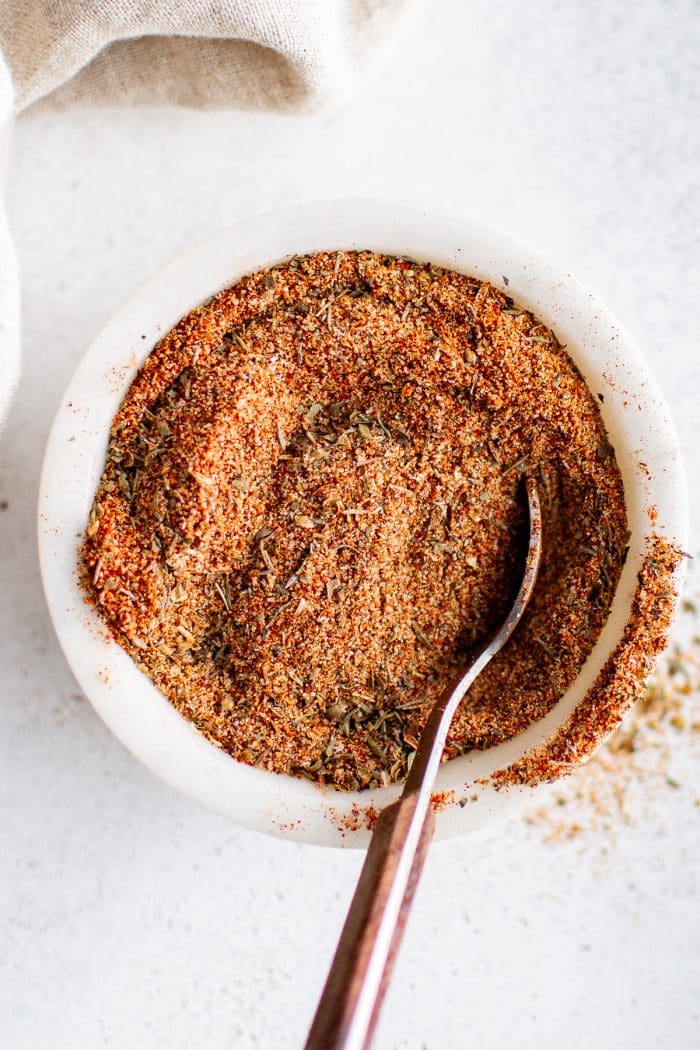
Creole Seasoning Recipe
Ingredients
- 2 tablespoons paprika
- 2 tablespoon garlic powder
- 1 tablespoon onion powder
- 1 tablespoon dried oregano
- 2 teaspoons dried thyme
- 2 teaspoons dried basil
- 1 teaspoon freshly ground black pepper
- 1 teaspoon sea salt, optional
- ½ teaspoon cayenne pepper
Instructions
- Mix the spices: Add all ingredients to a small bowl or jar. Stir or shake until fully combined. Optional: Add all ingredients to a mini food processor. Pulse 1-2 times to unify the texture and combine fully.
- Store or use: Use immediately, or transfer to an airtight container and store in a cool, dry place for up to 3 months.
Notes
- Use fresh spices: For the most vibrant flavor, use spices that are less than 6 months old. Dull color or faint aroma often indicates they’ve lost potency.
- Double or triple the batch: This seasoning stores well and can be used in many dishes make extra and store in small jars for convenience (or gifts!).
- Shake before using: If stored for a while, some settling may occur. Give it a quick shake or stir to redistribute the flavors.
- Salt-free option: Omit the salt to create a salt-free Creole seasoning blend. Add salt separately to dishes as needed.
- Creole seasoning is not the same as Cajun seasoning: Although they are very similar, Creole seasoning is less spicy and more herb-forward, with a more balanced, aromatic profile.
- Make it your own: Adjust the level of cayenne to control the heat, or add extra herbs like marjoram or parsley for a more personalized blend.
- Paprika: Use smoked paprika for a bolder, deeper flavor, or a mix of sweet and smoked.
- Garlic + onion powder: This recipe can be made with powdered or granulated forms.
- Storage: Store in an airtight container, spice jar, or mason jar in a cool, dry place. Best used within 3 months.
Nutrition
Nutrition information is automatically calculated, so should only be used as an approximation.

